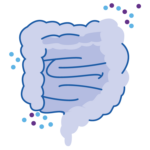The past decade has witnessed tremendous efforts in Alzheimer’s disease (AD) research.
Tau and Aβ have long been classified as the pathological hallmarks of AD however therapeutic progress based on the tau and amyloid cascade hypotheses has remained slow.
More recently, neuroinflammation has been identified as a unifying biological principle of homeostatic destabilization affecting the risk, onset, and progression of neurodegenerative diseases. Genetic, exposome, and microbiome variation have all been found to contribute to pro-inflammatory responses.
Here we will take you through the contributing risk factors behind neuroinflammation, it’s supposed role in the development of AD, and potential therapeutic consequences.

Exposome
The so-called “AD exposome” refers to lifestyle-associated risk factors for AD and associated dementias which can contribute to an inflammatory response in the CNS that may tip the balance toward initiating disease and exacerbating the progression of AD neuropathology.
The list of risk factors under investigation is vast, so we have only included a selection here.
Microbiome
Imbalances in the human microbiota due to diet, chronic infection, environmental exposures, or the aging process are thought to lead to increased Aβ production and accumulation. The assessment of resident microbes in the development and progression of AD is still in its infancy but a summary of the current understanding is below.
Genetics
In most cases, Alzheimer’s does not have a single genetic cause. It can be influenced by multiple genes in combination with the lifestyle and microbiome factors mentioned above. Some of the genes currently known to increase the risk of AD are listed below.
Pathology
Pathology
Pathology
Peripheral and systemic inflammation may initiate, aggravate, or accelerate the three core pathologies associated with AD: tau tangles, Aβ plaques, and neuroinflammation.










Aβ plaques
Tau tangles
Neuroinflammation











Under physiological conditions, homeostatic microglia survey the brain microenvironment.
Microglia perform immune surveillance and provide trophic support to the CNS and are involved in the maintenance of synaptic homeostasis and neuronal plasticity.
Astrocytes form the outside layer of the BBB and protect synapses.
Homeostatic astrocytes regulate cerebral blood flow, maintain synaptic homeostasis, and provide neurotrophic support.






Release of neurotrophic
factors
Blood-brain
barrier
Astrocytes maintain
blood flow
Release of
neurotrophic
factors
Microglia scanning for damage,
scaling and pruning



Pattern recognition receptors on microglia detect Aβ in the vicinity.
The binding of Aβ activates the microglia.
Microglia start to engulf Aβ fibrils via phagocytosis and degrade soluble Aβ by extracellular proteases such as insulin degrading enzyme.
Activated microglia produce pro-inflammatory cytokines such as TNF-α, IL-1, IL-6, IL-12 and IL-1B.
Under physiological conditions, Aβ is produced at high levels in the brain and cleared at an equivalent rate.




Uptake and clearance
of Aβ

Pro-inflammatory cytokines released

Acute inflammation
as part of immune response
and healthy neural homeostasis





Aβ production increases with aging. Aβ deposition alone may be sufficient to induce an inflammatory reaction leading to the development of AD.
Aggravators described earlier (e.g., obesity, type 2 diabetes, infection) can modify the innate immune response caused by Aβ-exposed microglia, promoting a sustained and systemic pro-inflammatory state.
Increased cytokine levels cause reduced microglial phagocytic capacity by downregulating Aβ phagocytosis receptors and enhanced Aβ production.
Sustained microglia activation and exposure to Aβ triggers NLRP3 inflammasome activation.
NLRP3 inflammasome activation leads to further release of pro-inflammatory cytokines and pyroptotic proteins, such as ASC specks.
The ASC specks act as binding cores for Aβ aggregation which further activates inflammasomes.
Exposure to ASC-Aβ composites further amplifies the pro-inflammatory response resulting in increased pyroptotic cell death and build-up of Aβ plaques.


Different states of activation

Hyperinflamation


Pro-inflammatory
markers
Small dead or dying microglia.





ASC speck groups
Aβ into a plaque

ASC Speck
is released.


Increased inflammatory cytokines and a buildup of Aβ also activates astrocytes, although it is currently unclear whether this requires prior microglial activation.
Reactive astrocytes release further pro-inflammatory cytokines, chemokines, and other neurotoxins.
The NF-κB pathway in reactive astrocytes is also instigated, releasing complement cascade components such as C3 and C1q.
Peripheral inflammation and reactive astrocytes can reduce the expression of tight junction proteins, such as claudin-5, responsible for the selective permeability of the BBB.
The BBB breakdown facilitates entry of neurotoxic chemicals into the brain.







Activated microglia and
Aβ activate astrocytes
Release of neurotoxic
chemicals into the brain
Activated astrocyte
releases C3, C1q and other
proinflammatory molecules

C3 and C1q released by activated astrocytes bind to synapses.
Activated microglia bind C3-tagged synapses and cause phagocytosis, releasing further neurotoxic and pro-inflammatory factors.
Pro‐inflammatory microglia are thought to have a direct neurotoxic effect by releasing detrimental compounds, including ROS and NO.
Pro-inflammatory cytokines bind to receptors on the axon which initiates an intracellular pathway leading to the hyperphosphorylation of tau.
Abnormally hyperphosphorylated tau loses its biological activity and disassociates from microtubules causing microtubule disintegration.
Hyperphosphorylated tau also promotes its polymerization.
Tau oligomers are toxic to neurons and cause further polymerization into highly aggregated paired helical filaments and neurofibrillary tangles.


















NO, ROS and immune mediators
released by inflamed microglia
Direct
neurotoxic
effect




The sustained inflammatory state of microglia and astrocytes causes constant release of pro-inflammatory cytokines and chemokines thus resulting in neuroinflammation.
This causes a buildup of Aβ plaques and neurofibrillary tangles
leading to neuron death.









Therapeutic Consequences
As with all diseases, improved understanding of the complex mechanisms behind AD progression can highlight therapeutic targets.
Therapeutic Consequences of GLP-1
GLP-1 is produced in the brain and displays a critical role in neuroprotection and inflammation by activating the GLP-1 receptor signaling pathways.
GLP-1RAs are already established therapeutic options for T2D and obesity, two of the highly causative risk factors for AD.
More recently their role in cognition has come to light.
GLP-1RAs have been shown to be potent anti-inflammatory molecules that can modulate microglial and astrocyte activation, possibly through inhibition of the NF-κB pathway.
It is thought that through inhibiting some of the pathological mechanisms described above, they can...
...reduce neuroinflammation

...promote microglial homeostasis

...improve vascular integrity

...reduce obesity-related cytokine release






... and so protects the brain.



